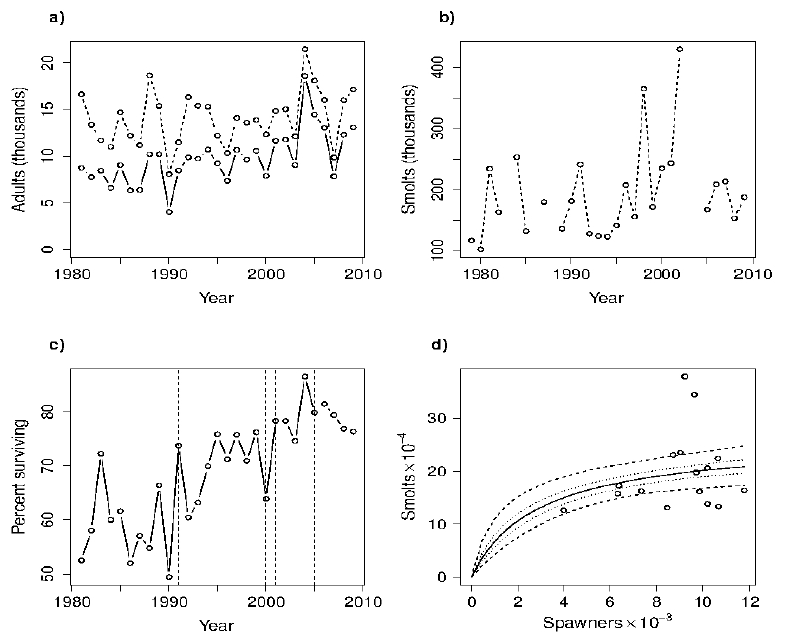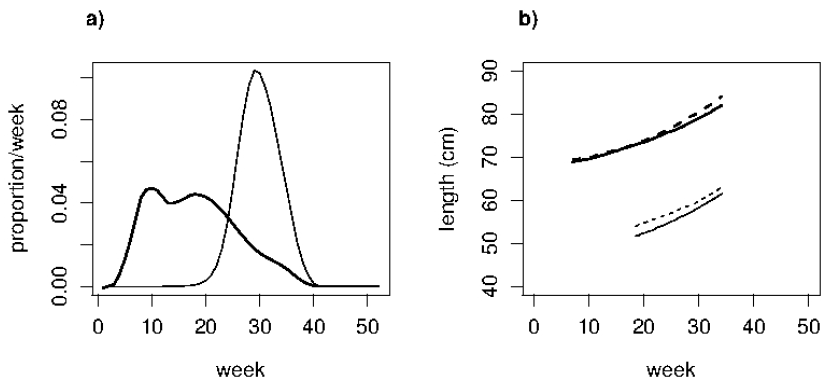Scottish Marine and Freshwater Science Vol 6 No 12: The demography of a phenotypically mixed Atlantic salmon (Salmo salar) population as discerned for an eastern Scottish river
This report investigates the potential for assessment of fish populations at a sub-river
scale. A sophisticated mathematical model was used to separate salmon from a
single river (North Esk, eastern Scotland) into three sub-stocks, based on the
number
Results
The North Esk Population as a Single Entity
The aggregated totals (over all sea age classes) of pre-estuary adults and spawner numbers changed slowly over the study period (Fig. 2a), with the latter slowly approaching the former (as emphasised by the proportion of PEA surviving to spawn, Fig. 2.c). Total smolt-production was highly variable, with a slight overall increase (Fig. 2.b).
All of the fishery management actions (with the possible exception of catch-and-release ( C&R), which took some years to become established), might be expected to produce an observable co-incident increase in the proportion of the pre-estuary population ( PEA) which survives to spawn. However, only the 1991 change in the fishing method used at Morphie Dyke seemed to have been large and sudden enough to produce an immediate change that was big enough to be distinguished from year to year variability (Fig. 2.c).
Figure 2. Demography of the North Esk salmon population viewed as a single entity, deduced using grilse-error corrected rod-capture data. Frame a) shows numbers of adults returning to the estuary ( PEA - dashed) and adult spawners (solid). Frame b) shows total smolt production. Frame c) shows percentage survival of pre-estuary individuals to spawn. Vertical dashed lines show management actions : 1991 - Morphy Dyke nets replaced by rods; 2000 - Net season delayed to 1 st April; 2001 -: rod caught MSW's released; 2005 - Net season delayed until 1 st May. Frame d) shows the BH spawner to smolt stock recruitment relation. Points are data re-interpreted using equation 6. Solid line shows the median expected stock-recruitment relation, and the dashed and dotted lines show the 95% and 50% credibility limits. Note that frame (d) contains several fewer data-points than frames a-c. This is both because gaps in the annual smolt estimation record (frame b) prevent correct smolt totals being assigned back to birth-cohorts either side of the gap (according to number of age classes crossing the gap) and also because adults spawning from 2004 onwards do not have offspring returning as 2 SW fish by the end of the data-series (needed to provide smolt sub-stock composition via equation 6 , and here omitted for consistency with the sub-stock results of Fig.4 below).

Modal SR parameter values (posterior BH estimates) from the grilse-error corrected datasets showed slight differences from those derived from data not corrected for grilse-error, but the discrepancies were very small compared to the widths of their 95% credibility regions (Table 1 and Fig. 2d) . The corresponding results for 'uncorrected' data are in Supplementary Material, part B. The estimated modal value of θ =11.89 implied that, with stochastic model predictions at a given stock level, the yearly recruit numbers will vary around their expected mean value (at that stock) with a CV of 29%.
Table 1. Posterior parameter distribution for the North Esk 1980-2004 spawner to smolt data regarding the system as comprising a single stock, and using a Beverton Holt Estimated Stock-Recruitment ( ESR) curve with a control prior and using data corrected for grilse error. First two columns show the pair of parameters O max, H, defining the BH SR curve-shape. The third column, θ , represents the negative binomial error distribution factor . The next two columns are biologically informative values derived from the former three columns. The fourth column shows the (approx) modal coefficient of error variation implied by θ (see Gurney et al. (2010), equation 2). The fifth column shows maximum individual productivity, β, (equation 8). The top line of each pair shows the mode and the lower line shows the upper and lower 95% credibility limits. See Supplement part B for the like results using un-corrected data (rod-catch data stratified using angler-reported sea-ages).
| Parameters defining the BH SR curve | Estimated error | Derived biological param.s | |||||||
|---|---|---|---|---|---|---|---|---|---|
| O max Mode |
H mode |
θ mode |
CV(%) ≈ 1/√ θ mode |
β ≈ O max/H mode |
|||||
| 2.5% | 97.5% | 2.5% | 97.5% | 2.5% | 97.5% | 2.5% | 97.5% | 2.5% | 97.5% |
| Data Corrected for grilse error | |||||||||
| 24.80× 10 4 | 2.232 × 10 3 | 8.08 | 35% | 111 | |||||
| 20.00×10 4 | 36.71×10 4 | 0.978×10 3 | 7.154×10 3 | 3.85 | 17.09 | 51% | 24% | 51 | 204 |
Sub-stocks Partitioned by Sea-age and Run-time
The full 12 month difference in time spent at sea between the earliest returning adults from a given smolt-year-class (grilse) and the latest (late-running multi-sea winter fish), Fig. 3a, would prevent a simple mortality calculation (as a per-capita per unit time mortality rate) even for the total data-set. Although the smoothed distributions shown in Fig. 3a suggest that the recorded grilse run was uni-modal and confined to weeks 22-40, the MSW distribution was evidently both much broader and more complex, with fish running abundantly from weeks 5-25, and then declining gradually until week 40. Around week 20 to 21 was a convenient date on which to separate early- and late-running MSW components.
Figure 3. Smoothed within-year patterns of Atlantic salmon returns. a) Proportion of total North Esk net & coble catches of multi-sea-winter (heavy line) and grilse (light line) made each week. b) Expected body-lengths of two sea-winter (heavy lines) and grilse (light lines) females arriving at the Scottish coast against week of arrival, with individuals who smolted at river age 1 being shown by a solid line and those smolting at river age 3 by a dashed line. Both frames are compiled from a compendium of data obtained over the period 1967-2003. Frame a) is smoothed using R-routine supsmu with default parameters. Frame b) is computed and redrawn from a GAM model of the characteristics of Atlantic salmon returning to the Scottish coast (see Bacon et al. 2009 for its justification).

Although it may have been desirable to similarly separate earlier and later running grilse, as was done for MSW fish, Fig. 3 indicated that any attempt to do so for grilse on or around week 21, would place the separator on the steepest portion of the grilse run-time distribution: it would thus yield results which were sensitively dependent on the overall choice of separation date, and also on any inter-annual variations in the actual return-date distributions. Unpublished attempts to separate smolts into adult-return phenotypes based on smolt characteristics (smolt-size, smolt-timing or smolt freshwater-age) were extremely unsuccessful. This study accordingly subdivided the modelled population into three sub-stocks: early-run MSW (fish running before June 1 st); late-run MSW (on or after June 1 st); and all grilse. This choice of three components also matched existing, pragmatic, management practices ( i.e. the separation of early and late MSW fish and grilse), whose 01-June separation date was accordingly adopted.
Contact
There is a problem
Thanks for your feedback